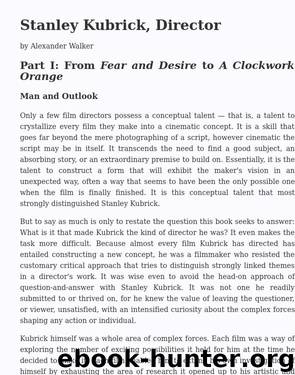Stanley Kubrick, Director by Alexander Walker

Author:Alexander Walker
Format: epub
Part II: Kubrick's Use of Color
Nowadays, no tyro director has second thoughts: his or her first film will be in color. But Kubrick's color sense came late to him, and possibly reluctantly. If one excludes Spartacus — which he did, judging that he labored on it under Kirk Douglas's "supervision" — Kubrick let fifteen years go by between his very first feature and his first film in color, 2001: A Space Odyssey. Even allowing that color came into general use only in the mid-to-late 1950s, as part of the cinema's counterattack against black-and-white television, this longish waiting period doesn't suggest any eagerness on Kubrick's part to work in color. Nor should it. Kubrick's eye was trained in the workshop of monochrome news magazines — just as his ear had been tuned by radio in the 1930s and 1940s. The marvelous opportunities for expressionism that monochrome photography made available to him had their historical resonances in the old High German cinema of the 1920s and early 1930s: the tones of these films created a subtle range of mood and an atmosphere that appealed powerfully to Kubrick's temperament.
Color, for him, became an imperative only with his venture into space. And even 2001, with the exception of the "Star Gate" sequence, seems to employ a palette of the starkest limitations. White, black, and red are its predominant hues: the black of space, the white of the spacecraft in it, the red glow bathing the crew inside the craft at moments of tension, peril, or disaster. Such a narrow color band derives in part from the technology of the setting: the future doesn't exactly appear to be a riot of color. Everyone recalls one early sequence in the film, the space hotel, primarily because the custom-made Olivier Morgue furnishings, those foam-filled sofas, undulant and serpentine, are covered in scarlet fabric and are the first stabs of color one sees. They resemble Rorschach "blots" against the pristine purity of the rest of the lobby. It's more than a fashion statement, although to this day, the original Morgue designs command high prices in the auction rooms, and the 2001 provenance is invariably cited in auctioneers' catalogs. Their designer's name, Morgue, has a baleful ring, considering the living tomb that the spaceship will become — a coincidence not lost on Kubrick.
Red "runs" into other premonitory sequences. When HAL 9000 covertly scrutinizes the two astronauts who are conspiring against him, the computer's single red eye is in the traditional hue of an alarm signal. When the mutinous HAL has to be subdued, Kubrick irradiates the setting with the color he himself most enjoyed working in: the infrared light of the photographer's darkroom. It's an ominous and magical illumination that suffuses every inch of the screen equally as Keir Dullea proceeds to shut down HAL's cerebral functions one by one. The flat red light forces one to peer, rather than simply look, adjusting to the scene in the way a man bending over a developing tank fixes his attention on the image that's becoming visible in the fluid.
Download
This site does not store any files on its server. We only index and link to content provided by other sites. Please contact the content providers to delete copyright contents if any and email us, we'll remove relevant links or contents immediately.
| Coloring Books for Grown-Ups | Humor |
| Movies | Performing Arts |
| Pop Culture | Puzzles & Games |
| Radio | Sheet Music & Scores |
| Television | Trivia & Fun Facts |
The Kite Runner by Khaled Hosseini(5085)
Gerald's Game by Stephen King(4584)
Dialogue by Robert McKee(4323)
The Perils of Being Moderately Famous by Soha Ali Khan(4171)
The 101 Dalmatians by Dodie Smith(3454)
Story: Substance, Structure, Style and the Principles of Screenwriting by Robert McKee(3399)
The Pixar Touch by David A. Price(3366)
Confessions of a Video Vixen by Karrine Steffans(3246)
How Music Works by David Byrne(3187)
Fantastic Beasts: The Crimes of Grindelwald by J. K. Rowling(2995)
Harry Potter 4 - Harry Potter and The Goblet of Fire by J.K.Rowling(2990)
Slugfest by Reed Tucker(2943)
The Mental Game of Writing: How to Overcome Obstacles, Stay Creative and Productive, and Free Your Mind for Success by James Scott Bell(2847)
4 - Harry Potter and the Goblet of Fire by J.K. Rowling(2657)
Screenplay: The Foundations of Screenwriting by Syd Field(2576)
The Complete H. P. Lovecraft Reader by H.P. Lovecraft(2514)
Scandals of Classic Hollywood: Sex, Deviance, and Drama from the Golden Age of American Cinema by Anne Helen Petersen(2467)
Wildflower by Drew Barrymore(2445)
Robin by Dave Itzkoff(2386)
